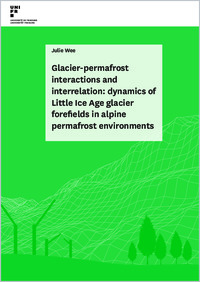Glacier-permafrost interactions and interrelation : dynamics of Little Ice Age glacier forefields in alpine permafrost environments
DOKPE
- Fribourg (Switzerland) : Université de Fribourg, 2025
1 ressource en ligne (vii, 194 pages)
Thèse: Université de Fribourg (Suisse), 2025
French
Little Ice Age glacier forefields in alpine permafrost environments are shaped by complex glacier–permafrost interactions. These transitional systems, at the crossroads of glaciology, geomorphology, hydrology, paleo-climatology, and natural hazard assessment, result from interconnected glacial, periglacial, nival, and gravitational processes. Their morphologies often transcend simple landform classifications, combining glaciogenic debris, debris-covered and buried glacier ice, and thermally controlled creeping landforms such as rock glaciers, sometimes disturbed by glaciotectonic stress. Recognizing these interactions is fundamental, as they generate morphologies that go beyond simple either-or-type classifications and are essential to understanding the long-term evolution of high-mountain landscapes. Because of their thermal inertia, viscous permafrost creep landforms can persist over millennial timescales and act as archives of past climatic oscillations. Repeated glacial and interglacial phases throughout the Holocene and historical glacier advances have driven successive geomorphic transformations that shaped present-day forefields.
This thesis investigates Little Ice Age glacier forefields in alpine permafrost environments of the western and southern Swiss Alps, focusing on their internal structure, thermal evolution, and kinematic behaviour across temporal and spatial scales. A multi-method approach integrating geophysical, geodetic, and thermal investigations reveals a heterogeneous distribution of ground-ice content and origin, controlling the sensitivity of landforms to thermally driven processes. Variations in kinematics are linked to landform genesis, debris-cover thickness, and slope. Surface changes are mainly governed by ice melt-induced subsidence and permafrost (back-)creep deformation, while coarse-debris mantles and thick debris covers promote ground-ice resilience despite ongoing atmospheric warming.
This thesis investigates Little Ice Age glacier forefields in alpine permafrost environments of the western and southern Swiss Alps, focusing on their internal structure, thermal evolution, and kinematic behaviour across temporal and spatial scales. A multi-method approach integrating geophysical, geodetic, and thermal investigations reveals a heterogeneous distribution of ground-ice content and origin, controlling the sensitivity of landforms to thermally driven processes. Variations in kinematics are linked to landform genesis, debris-cover thickness, and slope. Surface changes are mainly governed by ice melt-induced subsidence and permafrost (back-)creep deformation, while coarse-debris mantles and thick debris covers promote ground-ice resilience despite ongoing atmospheric warming.
- Faculty
- Faculté des sciences et de médecine
- Department
- Département des Géosciences
- Language
-
- English
- Classification
- Geography
- Notes
-
- Bibliographie
- Other material characteristics
- illustrations
- License
- Open access status
- diamond
- Identifiers
-
- SWISSCOVERY 991172638888405501
- DOI 10.51363/unifr.sth.2025.065
- URN urn:nbn:ch:rero-002-123358
- Persistent URL
- https://folia.unifr.ch/unifr/documents/333093
Statistics
Document views: 131
File downloads:
- phd_weej: 98
